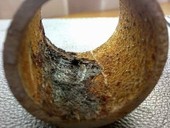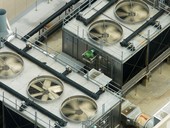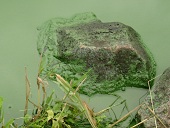This paper addresses the use of rainwater runoff from surface to supply buildings. In the future drinking water supplies will steadily decrease but need of drinking water, given the continued growth of the population, is still rising. Although flat roofs are just a fraction of the total area of urban surface runoff, even small tanks have a favorable influence on the drainage area. Previously, it was a concrete tank, today is the most common plastic material.
The article is a contribution to the issue of the use of rain water from surface runoff for water supply buildings. It analyzes and reflects on how you can use rain water in building, the basic layout of rain water tanks and describes design method of calculating the volume of the tank and the volume of water in the tank.
Archiv článků od 2.1.2012 do 25.6.2012
The biodegradable waste is commonly contained in solid household waste. Its amount is not neglected and its value is great for reusing, so it is necessary to determine suitable systems for dealing with this specific component. The hydraulic piping system helps to solve questions about collection, sorting and transport this type of waste. The paper introduces systems for transport biodegradable waste and speaks about their advantages, disadvantages and areas of their suitable using.
Manage of rainwater is turning into ecological necessity. Altough rules for absorbing rainwater into soil is effective since 2009, rainwater is still understanded as problem, where is quick-and-cheap solution preferred. Most people doesn‘t know size of problems wich can be caused by current attitude.
This article presents monitoring of internal heat-humidity microclimate in the bathroom of a typical family house. The text presents the results of measurement confronted with the requirements of current legislation. Temperature and humidity are the basic components of internal microclimate and as such contribute significantly to indoor air quality in residential and civic buildings. If the measured room bathrooms, whose character says that it will lead to significant gains water is then necessary to pay attention to the humidity. This may be their high value negatively affect the health of users indirectly by creating conditions for development of microorganisms and fungi. High humidity also has influence on some structures, the sensitivity to this aspect of the microclimate of a variant of the materials vary. The text presents the results of measurements which took place from 19.02.2011 to 06.14.2011.
Current and future use of rainwater in urban and rural areas with a dense network of residential and industrial buildings, including paved surfaces, can be transformed from the standard of environmentally and economically non-viable leads into sewers or waterways to capture this source of water through infiltration to the soil of the specific hydrogeological site.
The paper is to highlight the cunning of material use with risk of corrosion that requires an increased measures to achieve a number of parameters in the design and operation of pipe networks. Even when all laws and regulations, guidelines or recommendations are met, life time does not reach the anticipated 50 years.
At a European level a Directive of the European Parliament and Council 2010/31/EU on the energy performance of buildings (EPBD) has been released in 2010 whereas the main requirement is to reduce energy consumption in buildings (replacing 2002/91/EC). A set of European standards have been issued for its implementation, eg EN 15232 Energy performance of buildings - Impact of automation, control and management of buildings. In the Czech Republic the Directive was implemented by Act No. 406/2000 Coll. energy management and decree 148/2007 on the energy performance of buildings. The current global trend is characterized by promoting energy efficient technologies. The aim of this work is to summarize domestic household consumption, it´s prediction and analysis of potential energy savings by using the wiring system (BACS).
The article is a contribution to the issue of rainwater infiltration from surface runoff and describes how to design infiltration shafts. The most important indicator is the absorption coefficient in the subsoil, respectively at the point where infiltration devices is placed. The coefficient of permeability of soil expresses the velocity in m/s, the rainwater flows through a certain type of environment, ie soil.
In recent years, there have been faults in construction (mainly pitting) on galvanized steel pipe. Apparently it is lost historical memory. A similar situation was in the years 1960-1970. Based on faults of interior galvanized steel water pipes with pitting corrosion, various technical measures were adopted.
Less experienced operating managers in the branch of mechanical services of building can easily get difficulty in identifying the causes of technical problems, which sometimes a common practice brings. The article gives a table of causes and effects of defects and disorders related to cooling and heat sources.
The use of GE depends on the predisposition source, namely geothermal boreholes. The use itself is different when using the heat for heating, hot water, heating greenhouses and plastic greenhouses (agricultural), recreation facilities, but also for various technologies. The inclusion of monitoring and control system for an open geothermal energy system is achieved by taking friendly geothermal water and substantially increases the life of the whole work.
Design of roof drainage vacuum system is based on the principle of hydraulic fluid flow. If you comply with all the basic rules, and set boundary conditions, it is expected that the proposed system will work. Given that the design of vacuum system is very difficult, even technically, designers often use direct supplier systems.
This article summarizes the findings about the quality and quantity of waste water at the outlet of gravity and alternative methods of drainage and the subsequent impact of water to the WWTP. Results of monitored indicators vary depending on the type of sanitation, especially in indicators BSK5, CHSK and N-NH4+ thus the indicators that are affected by oxidation-reducing conditions in the sewer.
The problem of pollution of surface water by nutrients, especially phosphorus and consequences of mass development of cyanobacteria is becoming increasingly serious. Excessive intake of nutrients and organic matter deposition leads to deterioration of water quality and leads to the development of cyanobacteria and thereby to reduce the recreational use of reservoirs as well as other use.
The true value of the water demand is needed for the optimized design of the water mains, their planning, development and rehabilitation too. In the case of large cities or towns, the standard approaches can be used. Whereas for the small municipalities, the water demand evaluation is too difficult for their individuality. The paper deals with some approaches to evaluate the water demand for small municipalities on the base of some measurements at chosen water supply systems.
zpět na aktuální články



















